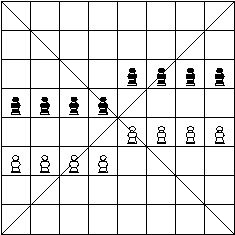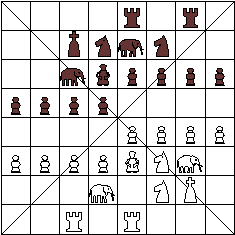Burmese Chess
Sittuyin is the name for the chess variant of Burma. Nowadays, in many parts of Burma, `usual' chess has taken the place of the Burmese variant, but it is still played in the northwest.
There have been many conflicting descriptions of the game. According to Pritchard, in his Encyclopedia of Chess Variants, these contained many errors. The description of the game below is based upon Pritchard's description; the description of Pritchard was based on a Burmese book on the game from around 1924, called Myan-ma sit bayin lan-nyunt sa-ok gyi, by Shwei-gyin U Bha, in consultation with several chess masters of that time.
The game is probably old, and may have been a direct (or almost direct) offspring from Chaturanga.
Rules
The game is played on an uncheckered board of 8 by 8 squares. Sometimes the board contains markings, e.g., often the diagonals are marked.
Each player has one king, one general, two rooks (actually: carriages), two knights (actually: horses), two elephants, and eight pawns (actually: soldiers). The colors are red and dark (or black); here called white and black.
The game starts with only the pawns put on the board. This starting setup is as below:
 White:
White:
Pawn a3, b3, c3, d3, e4, f4, g4, h4.
Black:
Pawn a5, b5, c5, d5, e6, f6, g6, h6.
Then, white puts all his pieces at the squares behind his pawns, as he wishes. After that, black deploys all his pieces behind his pawns. After that, the game `really' starts, with white moving one of his pieces with a normal move. It is also allowed to put pieces on the positions of pawns, and then to put such pawns on other squares in the area behind the pawns original position. There are certain restrictions on the setup of Black. For instance, white can object when black puts both rooks on the same column, or a rook on the same column as the king of white; then black has to change his setup such that this is no longer the case.
The king, the rook, and the knight move in the same way as in usual chess. There is no castling.
The general moves one square diagonally.
The elephant can move one square diagonally, or one square straight forward. E.g., a white elephant on d4 can move to c3, c5, d5, e3, or e5.
Pawns move as in orthodox chess, but cannot make a double step on their first move. A pawn promotes when it reaches a square on one of the diagonal lines on the opponents half of the board, i.e., a white pawn promotes on a8, b7, c6, d5, e5, f6, g7, h8. A pawn always promotes to general; a pawn can only promote when ones general has been taken. However, promotion is not immediate upon arrival on the square (as in usual chess.) Instead, when a pawn reaches a promotion square, he stays a pawn that move. In a later turn, the pawn can be changed into a general in the following ways (always provided the original general has been taken): no ordinary move is made that turn - instead the turn is used to change the pawn to general; the pawn makes a generals move and is simultaneously transformed into a general. However, in the latter one may not give check or take the general of the opponent with this move. It is possible for a pawn to move past the squares where he can promote: in that case, promotion is no longer possible for that pawn.
The player that mates his opponents king wins the game. A move that gives stalemate to the opponent is not allowed. A draw by eternal check or repetition of moves is possible.
Certain endgame rules, similar to the 50-moves rule, but perhaps even more similar to the endgame rules of Thai Chess (Makruk), are used. Pritchard does not give a full list, but mentions that when one has a rook and king against a lone king, then one must give mates within 16 moves - if not, then the player with a lone king can claim a draw. However, when the lone king is on one of the four squares in the center (d4, d5, e4, e5), then the 16 moves start to be counted after the 5th move of the lone king (effectively giving 21 moves).
Favourite opening setups
Burmese players have their favourite opening setups, and 33 were listed in the Burmese book, mentioned above. Below, you see the first of these.
 White:
White:
King g2; General e3; Rook c1, e1; Knight f2, f3; Elephant d2, g3; Pawn
a3, b3, c3, d3, e4, f4, g4, h4.
Black:
King c7; General d6; Rook e8, g8; Knight d7, f7; Elephant c6, e7; Pawn
a5, b5, c5, d5, e6, f6, g6, h6.
Written by: Hans Bodlaender. Thanks to: Michael Kaelbling for noting an error.
WWW page created: November 18, 1996. Last modified: February 24, 1997.